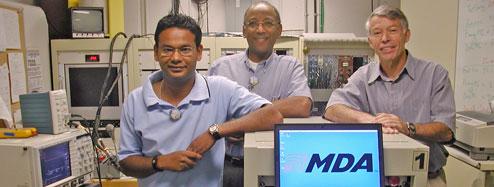
Electronics for the “Keep Alive Umbilical System” were recently tested by MDA (MacDonald, Dettwiler and Associates) engineers Rod Dixon and Zaeem Mohammed using the TRIUMF Proton Irradiation Facility. 100 MeV protons were used to simulate the space environment. The electronics is used for powering the Canadarm 1 extension when it is docked in the International Space Station. The extension arm is used by the space shuttle for tile inspection prior to re-entry.
The Proton Irradiation Facility (PIF) at TRIUMF makes use of two beam lines for low intensity radiation damage studies of electronics, detector components and other materials. Low energies, variable from as low as 15 MeV up to 120 MeV are available from the beam line 2C, which is also used on a regular basis for proton treatments of ocular melanoma. Higher energies, from 120 MeV up to 500 MeV, are available from a second beam line 1B which transports proton beams into the same experimental area.
The unique feature of the TRIUMF cyclotron is that it is capable of extracting simultaneously several beams of different energies and intensities. This is achieved by accelerating H- ions and using a stripping foil or wire, located at the correct radius in the cyclotron, to extract protons of the desired energy. The intensity is determined by the area of the stripping foil intercepting the beam and is adjusted with the height and shape of the foil.
The irradiation facility was designed primarily for single-event effect studies and characterization of electronics components for the space environment. The spectrum of trapped protons in earth orbits peaks in the 10-100 MeV energy region (depending on the amount of intervening absorber) and drops by about an order of magnitude at 500 MeV. A 10-year dose for the International Space Station can be delivered in about 15 minutes, or longer if desired. This makes the TRIUMF variable energy capability up to 500 MeV ideal for studies of space effects. Biological studies such as cell irradiations to measure RBE of protons are also being carried out in conjunction with the Proton Therapy Facility.
Each year, about 60 engineers and scientists from about 20 companies, labs, or universities visit TRIUMF to carry radiation testing.
